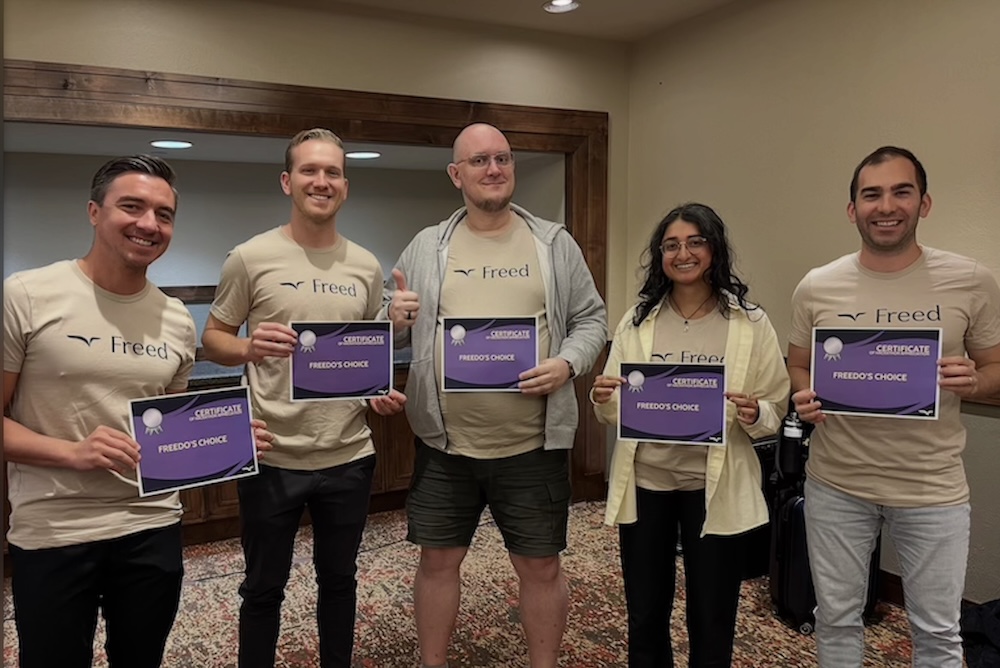Freed Hackathon: How We Built 5 Production-Ready Features in 24 Hours

Freed Hackathon: How We Built 5 Production-Ready Features in 24 Hours
A deep dive into our tech-forward culture, innovation process, and engineering solutions that impact thousands of clinicians.




Table of Contents
At Freed, we’re solving real problems for overworked clinicians. Too often, they’re staying late to finish charts or squeezing notes between patients.
That reality raises the stakes for every feature we design — and makes Freed a place where engineers know their work improves lives.
A hackathon felt like the perfect way to create amazing things for clinicians, quickly, while using top-notch AI.
Our inaugural hackathon posed a single challenge: What can we build in 24 hours that immediately improves a clinician’s day?
How Freed builds for speed and impact
Teams weren’t just groups of engineers. We used AI to balance skillsets to build groups across the entire org:
- Frontend and backend engineers
- Clinical specialists
- Data engineers
- Product, marketing, sales, and customer success professionals
This helped our engineers align with real-world user pain points and actual impact.
“We had a well-balanced team where everyone contributed in their own unique way. Our friends in sales have direct insight on the pain points our users face—it was invaluable having that perspective while building.” — Nikita Rau, Software Engineer
For engineers, it was a crash course in our culture: cross-disciplinary collaboration, rapid iteration, and seeing an idea go from sketch to prototype in a single day.
A technology-first approach
We handed all participants licenses to Gemini, ChatGPT, Cursor, and more with no restrictions.
"We gave everyone licenses to cutting-edge AI tools and encouraged them to use tools that they haven't previously used," explains Jon Radchenko, Engineering leader at Freed.
Experimentation wasn’t just encouraged — it was the whole point. As a company, we don’t simply tinker with AI. We apply it with urgency and creativity to solve real problems that clinicians face every day.
Of course, we sandboxed isolated environments and mock data, because we don’t use any real data in these scenarios.
Selection criteria and constraints
Out of 60 idea submissions, 10 were selected based on specific criteria:
- Feasible in one day
- Not on the existing product roadmap
- Outside the author’s traditional expertise
- Required cross-functional collaboration
- Strong AI focus
- Involved multiple departments
Every engineer had to think beyond code to deliver a usable prototype that clinicians could imagine using tomorrow.
Categories we celebrated
Each team had five minutes to present what they built. Instead of highlighting individual projects, we celebrated the work through five award categories that represent our values.
Best clinician impact
Everything we build starts with reducing clinicians’ mental load. This category recognized the prototype with the clearest, most immediate benefit. Judges looked for ideas that streamlined workflows, minimized cognitive overhead, and made it easier to end the day feeling lighter.
Most marketable concept
This category honored the project with the strongest real-world appeal. We wanted something that would fit naturally into how clinicians already work. Judges looked for concepts that felt intuitive from the start, solved a familiar pain point, and could translate cleanly into a product experience without adding friction.
Biggest “wow” factor
This award spotlighted the project that delivered that unmistakable hackathon magic: inventive use of AI, delightful execution, or an unexpected twist that made people stop and say, “Wait… you built that in 24 hours?”
Fastest path to launch
Some prototypes were engineered with such clarity and practicality that they felt only a few steps away from production. This category celebrated solutions built with thoughtful scope, realistic constraints, and craftsmanship. It balanced ambition with a clear path to becoming something clinicians could actually use.
Freedos’ choice (overall winner)
Our internal vote across all participants. This recognized the project that best balanced usefulness, creativity, execution quality, and alignment with real clinician needs.
Impact & why it matters
Stay tuned — you’ll see some of these winning concepts show up in upcoming product releases.
All five prototypes addressed direct clinician needs identified through ongoing feedback.
Several of these projects are entering the product roadmap for further development and deployment.
For engineers, it showcases what makes Freed different:
- Purpose-built problems: You’re not chasing abstract optimizations — you’re building tools that help clinicians get back to the work and lives they love.
- Room to experiment: Hack days are just one example of how we encourage bold ideas and rapid prototyping.
- Impact at scale: Solutions move quickly from prototype to production, reaching thousands of clinicians.
Our values in action
It just goes to show how 24-hour, focused innovation can produce solutions that change clinicians’ lives.
That’s the culture we’re building at Freed: fast, collaborative, and relentlessly focused on the people we serve.
Want to build innovative, AI-first tools that make clinicians’ lives easier? We’re hiring.
FAQs
Frequently asked questions from clinicians and medical practitioners.





